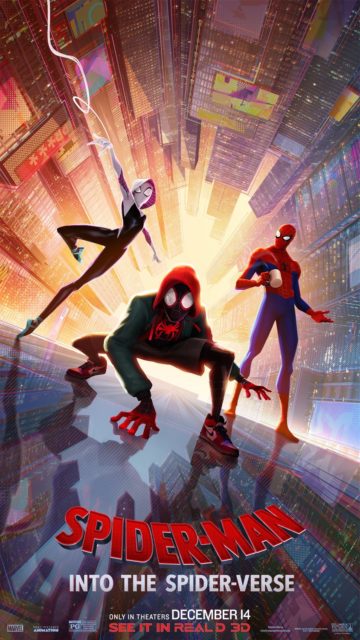We finally got around to watching Spider-Man: Into the Spider-Verse (2018) last night. As the film rights to Spider-Man are still owned by Sony, the film isn’t available on Disney+. Fortunately, we’re GenX’ers, which means we still have cable and a TiVo, so, go us!
I actually hadn’t been very spoiled about the story. I knew it was based on a comic book story – which I hadn’t read – and starred the Miles Morales version of Spider-Man – which honestly know almost nothing about – and that the animation was supposed to be great.
It was all that and more.
It was amazing.
It’s a take on Miles Morales’ origin story, and it has a surprisingly slow burn (the film is nearly 2 hours long, which is pretty lengthy for an animated feature film), building up to Miles getting his powers over the first third of the movie. But with a twist, as there’s already a Peter Parker version of Spider-Man in his dimension, and they both run afoul of a plot by the Kingpin which rips a hole between universes, resulting in five other Spider-people ending up in Miles’ dimension. Miles ends up being trained by an older, sadder Peter Parker, but also meets the others, especially Spider-Woman, Gwen Stacy on her world, who failed to save her best friend – Peter Parker.
As a Spider-Man origin story, it hits a lot of the beats you expect such a story to have: With great power comes great responsibility, death of a loved one, the outsider trying to fit in, triumph over great odds.
But this remix has a lot of touches which make it different, too. Miles isn’t being raised by his aunt and uncle, he’s being raised by his parents, and his policeman father wants the best for him, loves him dearly, but pushes him in a direction Miles doesn’t want to go. Miles finds a different father figure in the older Peter, but their relationship has issues, too, due to Miles’ inexperience. One always senses that Peter’s wisecracking persona as Spider-Man was a front, an escape from the sorrow that undercut his life. But for Miles it’s his true self, not an escape but an ability to be free, and so to gain confidence in his abilities in both his lives. Including an appreciation for his family.
The film is smartly written, upending a number of the conventions of Spider-Man, such as: Aunt May, who’s a much stronger figure here (I think inspired by J. Michael Straczynski’s version from his run); the older Peter’s sense of humor being much sharper and acerbic; and playing a little loose with secret identities.
It’s also very fun, and very funny. While there’s a sequence in the middle where Miles and Peter are breaking into a lab which is trying too hard, otherwise almost everything works. Peter has a quip for the gizmo they need to find to hack the device to send everyone home. He also shows his experience in escaping when Miles ties him up, but his not-really-caring attitude causes problems too. He needs this adventure to find himself as much as Miles does.
And of course there’s the big moment where Miles gets knocked down as far as he can go… and bounces back to become his own Spider-Man. It’s a scene that got a lot of accolades, and they’re all deserved.
The animation is beautiful. It’s not for everyone, as it’s frenetic and flashy and jerky-jerky (by design – some of the “how the animation was done” videos are pretty neat). The art style is just about perfect – how far computer animation of human beings has come in the years since The Incredibles. The staging of some of the action sequences must have been insane to storyboard and then animate.
This was one of the most fun superhero films I can recall watching. Highly recommended if you haven’t seen it.


